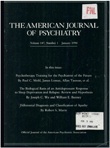Comparison of mania and depression after brain injury: causal factors
Abstract
Patients who developed secondary mania after brain injury (N = 17) had a significantly greater frequency of injury to right hemisphere areas connected with the limbic system than poststroke patients with major depression (N = 31), who had injury primarily in the left frontal cortex and basal ganglia. For patients without mood disturbance after brain injury (N = 28), the location of the lesion was not significant. Secondary mania patients also had a significantly greater frequency of family history of affective disorder than did the other two groups. These results suggest that an interaction between injury to certain areas of the right hemisphere and genetic factors or other neuropathological conditions produces secondary mania.
Access content
To read the fulltext, please use one of the options below to sign in or purchase access.- Personal login
- Institutional Login
- Sign in via OpenAthens
- Register for access
-
Please login/register if you wish to pair your device and check access availability.
Not a subscriber?
PsychiatryOnline subscription options offer access to the DSM-5 library, books, journals, CME, and patient resources. This all-in-one virtual library provides psychiatrists and mental health professionals with key resources for diagnosis, treatment, research, and professional development.
Need more help? PsychiatryOnline Customer Service may be reached by emailing [email protected] or by calling 800-368-5777 (in the U.S.) or 703-907-7322 (outside the U.S.).



